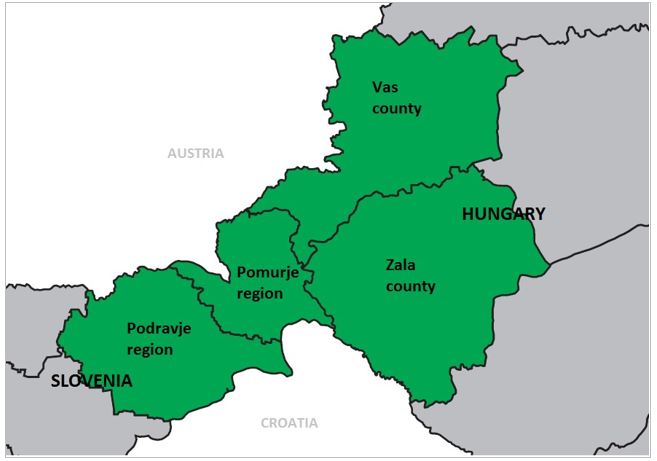The territory of the Slovenia-Hungary border region covers 10,658 km2 in total, 2/3rd of the area belongs to the Hungarian, 1/3rd to the Slovenian border region, divided by a border of 102 km in length. The programme area occupies the north-eastern part of Slovenia and south-western extremity of Hungary. Geographically the region is characterized mainly by alternating flat and hilly areas.
For the defined programme area the following key facts and trends characterizing are important:
- The programme area is characterized by an uneven distribution of population, which is concentrated in several more important urban settlements, while large parts of the Region are predominantly rural. The population is ageing, the area being affected by natural loss and facing a high negative migration. Due to the limited economic performance, especially to the weak economic potential of the rural areas, the unemployment and thus outmigration is relatively high and there is an increase in the number of people living at the risk of poverty. All these problems call for creating alternative local job opportunities in the remote areas on one hand and on the other good quality, accessible, innovative social services have to be available for moderating the significant social consequences and increasing the retention force of the human resource in the Region.
- The Region as a whole is well connected through the Budapest – Ljubljana highway, but the density and quality of the internal road network connecting the inner parts to this major transport corridor is insufficient. The public transport system is poorly developed both in general and in cross-border terms and does not contribute to the cross-border mobility. The limited intra-regional accessibility hinders the possibility of fully exploiting the economic potential of the programme area.
- The Region is rich in renewable energy resources, but – partially because of lack of supportive national policies – these are practically unexploited. In the perspective of the new energy policy environment, the increased use of these resources may be reconsidered, so their identification and further investigation may represent an untapped opportunity for the Region.
- The programme area is the shelter of a rich and valuable natural and cultural landscape enjoying special protected status (National Parks, natural protected areas, NATURA2000 areas). Being situated at the confluence of the two cultures the natural values are complemented by cultural heritage elements, both built and soft (multiethnic traditions, gastronomy) derived from the very long mutual interference. This rich natural and cultural heritage could be one of the drivers of the Region’s future development.
- As the situation analysis reveals, the tourism of the area is based mainly on important natural values as Lake Balaton, mountains (ski resorts), and thermal waters (spas). This resulted in a high spatial concentration of relatively well equipped tourist centers, attracting a high number of visitors. Nevertheless, besides the fairly developed tourist areas, the Region is providing excellent opportunities for “slow tourism” by developing new and novel ways for local heritage based agro/rural-tourism in the areas less developed in terms of tourism. This potential is currently underexploited due to insufficient visibility and promotion, lack of proper infrastructure and poor supply of local tourist products and services resulting in not having achieved the critical mass. Moreover, the Region’s existing tourist offer is not using the cross-border potential in terms of interconnecting the individual localities amongst and to the magnets/centers, and not integrating the resources of the two sides in border into more complex and appealing touristic products.










